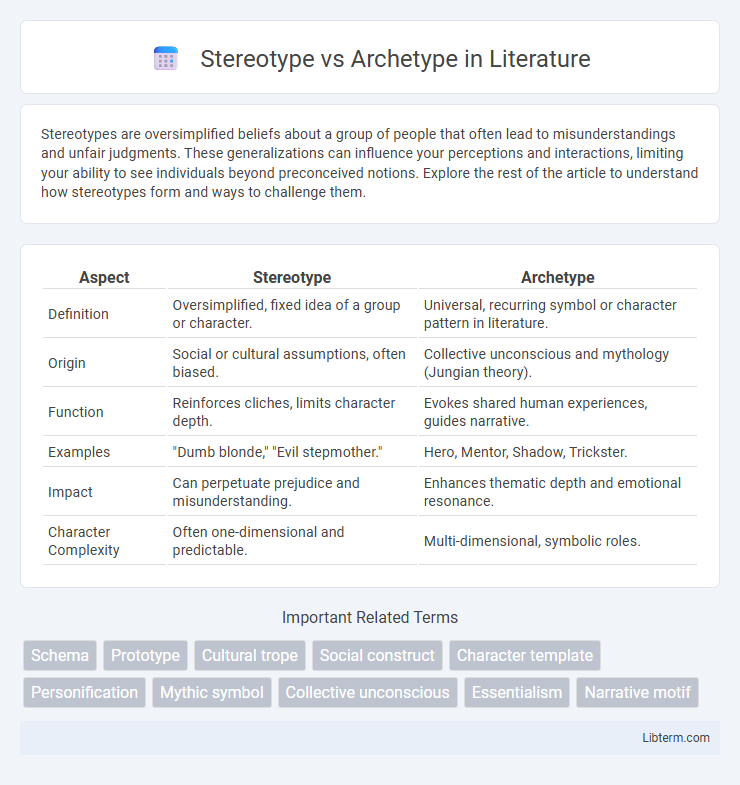Stereotypes are oversimplified beliefs about a group of people that often lead to misunderstandings and unfair judgments. These generalizations can influence your perceptions and interactions, limiting your ability to see individuals beyond preconceived notions. Explore the rest of the article to understand how stereotypes form and ways to challenge them.
Table of Comparison
| Aspect | Stereotype | Archetype |
|---|---|---|
| Definition | Oversimplified, fixed idea of a group or character. | Universal, recurring symbol or character pattern in literature. |
| Origin | Social or cultural assumptions, often biased. | Collective unconscious and mythology (Jungian theory). |
| Function | Reinforces cliches, limits character depth. | Evokes shared human experiences, guides narrative. |
| Examples | "Dumb blonde," "Evil stepmother." | Hero, Mentor, Shadow, Trickster. |
| Impact | Can perpetuate prejudice and misunderstanding. | Enhances thematic depth and emotional resonance. |
| Character Complexity | Often one-dimensional and predictable. | Multi-dimensional, symbolic roles. |
Understanding Stereotypes: Definition and Origins
Stereotypes are rigid, oversimplified beliefs about a group of people based on limited information, often rooted in cultural myths, media representations, and social conditioning. They arise from cognitive shortcuts that help individuals quickly categorize others but lead to distorted perceptions and generalized assumptions. Understanding the origins of stereotypes reveals their basis in historical context, power dynamics, and social identity, highlighting their role in perpetuating biases and prejudice.
What is an Archetype? Key Concepts Explained
An archetype is a universal symbol, theme, or character type that recurs across literature, mythology, and culture, representing fundamental human experiences and emotions. Key concepts include the collective unconscious, as defined by Carl Jung, where archetypes reside as shared psychic patterns influencing behavior and storytelling. Unlike stereotypes, archetypes offer deep, multi-dimensional insights into human nature, serving as foundational templates for character development and narrative structure.
Stereotype vs Archetype: Core Differences
Stereotypes simplify characters by assigning fixed, often exaggerated traits based on superficial group identities, whereas archetypes represent universal, timeless patterns found across cultures that convey deeper symbolic meanings. Stereotypes limit individuality and reinforce biases, while archetypes serve as foundational narrative roles that help audiences connect with fundamental human experiences. Understanding the core difference lies in recognizing stereotypes as reductive cliches, while archetypes embody essential, multi-dimensional motifs in storytelling.
Historical Context: How Stereotypes and Archetypes Evolved
Stereotypes originated from social and cultural generalizations often rooted in historical biases and power structures, solidifying simplistic, exaggerated traits about groups of people. Archetypes trace back to Carl Jung's theory of the collective unconscious, representing universal, symbolic figures and themes found across different mythologies and cultures throughout history. Over time, stereotypes have been challenged and deconstructed due to social progress, while archetypes continue to shape storytelling by providing deeply embedded narrative frameworks.
Psychological Impact of Stereotypes and Archetypes
Stereotypes often lead to cognitive biases and reinforce limiting beliefs, negatively affecting self-esteem and social behavior by fostering prejudice and discrimination. Archetypes, rooted in Jungian psychology, serve as universal symbols that influence personal development and collective unconscious, promoting psychological growth and self-awareness. Understanding the psychological impact of both helps unravel identity formation processes and the potential for overcoming mental constraints imposed by rigid stereotypes.
Common Examples in Literature and Media
Stereotypes in literature and media often reduce characters to oversimplified traits, such as the "dumb blonde" or the "evil villain," limiting depth and complexity. Archetypes, like the Hero, the Mentor, and the Trickster, serve as universal symbols that resonate across cultures and genres, providing foundational narrative roles with rich symbolic meaning. Common examples include Sherlock Holmes as the Detective archetype and the "mad scientist" stereotype representing obsessive intellect without ethical restraint.
The Role in Shaping Cultural Narratives
Stereotypes often simplify complex social identities into generalized, fixed traits, shaping cultural narratives by reinforcing biases and limiting diverse representation. Archetypes function as universal symbols and patterns in storytelling, providing a foundational framework that resonates across cultures and time. Together, they influence how societies interpret characters and values, with stereotypes risking perpetuation of prejudice while archetypes offer deeper thematic insights.
Benefits and Risks: When They Help or Harm
Stereotypes help simplify social information and predict behaviors quickly but often lead to unfair generalizations and reinforce biases. Archetypes provide universal, timeless models that enhance storytelling and personal growth by connecting individuals to shared human experiences. Misusing stereotypes can perpetuate prejudice and limit understanding, while misapplying archetypes may result in rigid thinking or cultural appropriation.
Breaking the Mold: Challenging Stereotypes and Redefining Archetypes
Challenging stereotypes involves dismantling oversimplified, often prejudiced notions that limit individuals based on group identity, fostering inclusivity and diverse representations. Redefining archetypes means evolving traditional, universal character models to reflect complex, multifaceted human experiences beyond predictable traits. Breaking the mold empowers authentic storytelling, promotes social awareness, and inspires innovation by expanding the boundaries of cultural narratives and character development.
Practical Tips for Writers: Using Archetypes and Avoiding Stereotypes
Writers enhance character depth by employing archetypes as foundational models, which provide timeless, relatable qualities without confining personalities to cliched traits. To avoid stereotypes, focus on developing unique motivations, backgrounds, and complexities that defy oversimplified group traits or predictability. Integrate archetypal patterns with multidimensional character arcs to maintain originality while resonating emotionally with readers.
Stereotype Infographic

 libterm.com
libterm.com